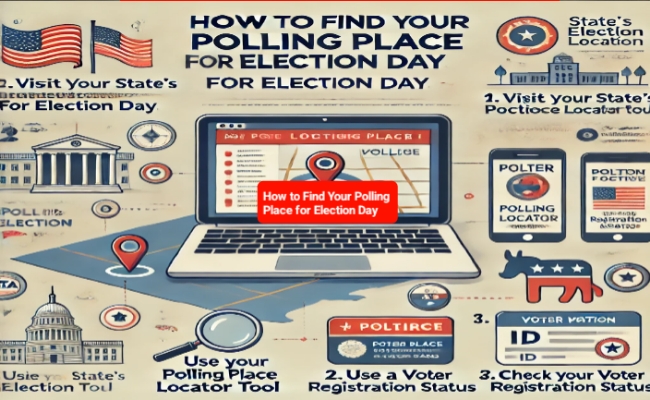How to Find Your Polling Place for Election Day: A Comprehensive Guide to Voting Locations Across the United States, Polling locations are typically assigned by local election officials at the city or county level.
How to Find Your Polling Place for Election Day
As Election Day approaches, one of the most critical questions on the minds of voters is simple but essential: Where do I vote? The answer varies based on where you live, but with the right information, finding your polling place is easier than ever. Whether you’re a first-time voter, recently moved, or just need a refresher, here’s everything you need to know to locate your polling station, prepare for voting, and make your voice heard in local, state, and federal elections.
1. How Polling Locations Are Determined
Polling locations are typically assigned by local election officials at the city or county level. Factors like population density, voter turnout, and community needs all play a role in determining these locations. Schools, libraries, community centers, and even churches are commonly used as polling sites because they’re familiar, accessible, and central to the communities they serve.
Each registered voter is assigned a specific polling location based on their residential address. The goal is to make voting as accessible as possible for all eligible residents. However, it’s essential to confirm your polling place because locations can change from one election to the next due to logistical updates, changes in voter registration, or even the impact of events like natural disasters.
2. Ways to Find Your Polling Location
There are several convenient ways to confirm your polling location before heading to vote:
a) Online State Election Portals
Each state has an online election portal where registered voters can access their voting information. Many of these websites provide a “Find Your Polling Place” or “Where to Vote” feature that requires only minimal information—typically your name, date of birth, or address. Once entered, the tool provides the assigned polling place, hours of operation, and any additional voting instructions.
b) Voter Registration Confirmation
If you’re unsure of your registration status, you can check your registration at various sites like Vote.org or your state’s election portal. If you’re registered, it will often display your polling place alongside your registration information.
c) County or Local Election Offices
County or local election offices maintain updated lists of polling locations, and their contact information can be found online. A simple call to the office can provide direct confirmation of your polling place, and they may also be able to answer other voting-related questions. Some offices may even offer multiple language options to accommodate diverse communities.
d) Mail Notifications and Voter Guides
Leading up to the election, many local election offices send out postcards or official voter guides that list polling locations and hours. Keep an eye on your mailbox for any communication from your election office, as it will often include information specific to your district and polling place.
e) Apps and Online Voting Tools
Several non-partisan organizations have developed voter assistance apps that can help you find your polling place. Tools like the Google Civic Information API, TurboVote, and BallotReady are designed to provide election information by simply entering your address. These services are mobile-friendly and can be helpful for checking last-minute information on the go.
3. Early Voting and Mail-In Ballot Drop Locations
Early voting is available in many states, allowing residents to cast their votes before Election Day. Early voting locations may differ from Election Day polling places, so be sure to confirm where these sites are in your area if you plan to vote early. Likewise, for those voting by mail, there are secure ballot drop-off locations available in many places, typically at designated drop boxes, election offices, or early voting sites.
To locate an early voting site or a ballot drop-off box:
- Visit your state’s election website and look for a link to early voting or ballot drop-off locations.
- Contact your county’s election office for detailed information.
- Use the same apps or tools mentioned earlier, as many have options to display early voting sites and drop boxes alongside Election Day polling locations.
4. Polling Hours and What to Bring
Each state sets its own voting hours, usually ranging from 7:00 a.m. to 8:00 p.m., but there are exceptions. In some states, as long as you are in line by the time the polls close, you are legally entitled to vote. This can be especially important in high-turnout elections when lines may be longer.
In most cases, you will need to bring a form of identification to vote. Commonly accepted IDs include:
- Driver’s license or state ID card
- U.S. passport
- Military ID
- Voter registration card (in some states)
Check with your state’s election website for a list of acceptable forms of identification, as voter ID laws vary widely by state.
5. Preparing for Election Day
Beyond finding your polling location, there are a few steps you can take to make the voting process smooth and stress-free:
a) Review the Ballot in Advance
Many states allow voters to view a sample ballot ahead of time. Reviewing the candidates, ballot measures, and propositions can help you make informed choices and reduce the time needed to vote.
b) Double-Check Polling Location Closer to Election Day
Polling places sometimes change last minute due to unforeseen circumstances, such as building closures or emergencies. Checking the night before or the morning of Election Day is a good precaution.
c) Bring Necessary Identification and Documents
While ID requirements vary, having an ID or your voter registration card can streamline your experience and avoid any potential issues.
d) Plan for Lines and Waiting Times
Be prepared to wait, especially during peak times like early morning, lunchtime, and late afternoon. Bringing water, snacks, and a phone charger can make waiting more comfortable if lines are long.
6. How to Avoid Common Voting Challenges
For some voters, accessibility and logistical challenges can complicate the voting process. Here’s how to address some common obstacles:
a) Accessible Polling Places
Federal law requires polling places to accommodate voters with disabilities, but it’s worth verifying that your polling site meets your needs. Many states offer curbside voting or assistive technology to support individuals with disabilities.
b) Transportation Assistance
If transportation is an issue, some organizations offer free rides to polling places. Organizations like VoteRiders and Uber often provide discounted or free transportation options to ensure that voters can reach their polling sites. Public transportation may also offer extended hours or free rides on Election Day in some areas.
c) Language Support
For communities with non-English-speaking voters, many polling places offer language assistance. If your polling place doesn’t provide language support, you are legally allowed to bring someone to assist you with translation.
7. Voting Alternatives: Absentee and Mail-In Voting
In cases where voters cannot make it to their assigned polling place on Election Day, absentee or mail-in voting is an option. The rules around mail-in voting vary widely, so check your state’s regulations and request a mail-in ballot as early as possible. To avoid disqualification, be sure to follow all instructions for filling out and returning your ballot.
8. Common FAQs about Polling Locations
Here are answers to some frequently asked questions about polling places:
- Can I vote at any polling location?
Generally, no. Most states require voters to go to their designated polling site to ensure they receive the correct ballot for their district. - What happens if I go to the wrong polling location?
In some states, poll workers may help redirect you to the correct site. In others, you may be allowed to cast a provisional ballot, but it may only be counted if you are verified as a registered voter in that jurisdiction. - Can I bring someone to help me vote?
Yes, federal law allows voters to bring someone for assistance, such as translation or accessibility support. However, there may be restrictions on who can accompany you, so check state guidelines.
Final Thoughts
Knowing where to vote is a critical part of participating in the democratic process. By taking advantage of available tools and resources, you can confidently locate your polling place and be prepared for Election Day. Remember that each vote counts, and showing up to the right polling location ensures that your voice is part of shaping your community and the country’s future.
How did you like the information given in our article today, please tell us in the comment section and for more such posts, follow our page the News House, thank you


